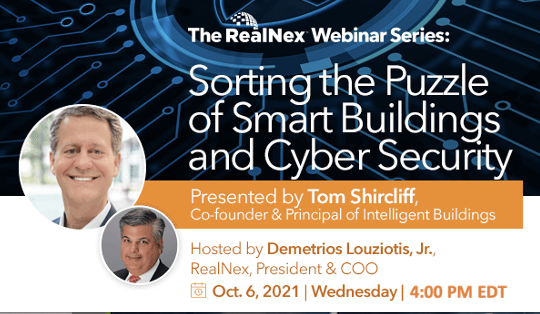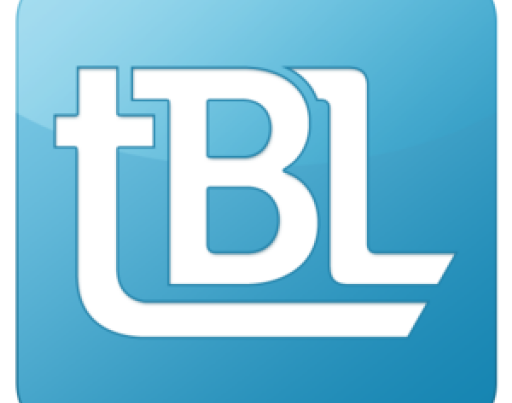This post originally appeared on tBL Marketplace Partner’s, RealNex blog RealNex Media Center Blog and is republished with permission. Find out how to syndicate your content with theBrokerList.
The RealNex Webinar Series continued on October 6, 2021, with the topic “Sorting the Puzzle of Smart Buildings and Cyber Security.” The session was hosted by RealNex President and COO Demetrios Louziotis and featured special guest Tom Shircliff, co-founder and principal of Intelligent Buildings. Intelligent Buildings is the leading advisory firm for smart building technology, working with Fortune 500 companies to small operators to improve their operations, security and ESG initiatives.
During the information rich hour-long webinar, Tom presented a framework for understanding, analyzing and implementing or improving smart building technology and why that process needs to include vendor risk management and cyber security.
The discussion focused on 4 primary drivers and approaches to creating and realizing value from Smart Buildings and Cyber Security initiatives:
- Building Backbone and Digital Twins
- Use Case Approach
- Vendor Risk Management
- Integration into the traditional Real Estate Process
Building Systems such as HVAC, Video Surveillance, Parking, Elevators, Lighting have all been “digital” or computer and network based for over 40 years. However, they have been designed, installed and maintained a value chain that has no IT or cybersecurity expertise. Additionally, they are installed as silos which prevents easy interoperability and data harvesting. During construction, converging these independent systems onto a backbone and centralized servers can be cost neutral while driving significant efficiencies and future value. With interoperability, costs can be more efficiently managed, public health and safety supported and cybersecurity better maintained. With a centralized infrastructure in place, additional services can be more easily added and third-party data can be readily consumed. Smart Buildings can not only handle and respond to activities within the building but can also instantly respond to data sources such as traffic, weather, utility and public safety.
Further, with sensors and data coming together, properties can be visualized digitally. These Digital Twins enable developers to simulate new services and optimize implementation. Modeling spaces and creating virtual buildings before work is done on real world facilities saves time and money and leads to faster and better decision-making.
Additionally, since we are in a marture real estate technology environment, you no longer have to start with systems and features, but rather can think and plan with use cases described in real estate and business terms. This allows you to describe outcomes and then simply utilized or acquire the technology necessary to satify the use case. Hence, a use case is more often an interaction between systems and not about a specific singular system. An example discussed was originally presented as a “parking problem”, while the actual need and Use Case was “getting employees from the street to their desk faster”. With this bigger picture view, an integrated system of parking, digital signage, lighting controls, elevators and access control was put in place to optimize the flow pattern. Other Use Cases might deal with Fire and Life Safety, Public Health and Wellness or Occupancy Experience. Each can be looked at holistically with interoperable systems, sequences and workflows put in place to improve building operations and customer experiences. Further each use case a “recipe” can be created to connect systems, sequence events and manage workflows. Once developed the recipe can be “baked into” the building to improve operational efficiencies, health and wellness and life safety. These initiatives are not one-time events to create a sustainable building, but rather must be continuously looked at and evaluated to maintain such status.
When analyzing a Smart Building Initiative, systems must be triaged to know what basic category they could be considered in. The first is the building’s core needs such as HVAC, elevator and lighting. The second is the business case or ROI with financial analysis. And, finally occupan experience where its neither core, nor has a specific ROI, but is a brand or experience expectation.
Before wrapping up, the discussion turned to Vendor Risk Management. In a quick analysis of a typical client with a 100-building portfolio it was determined that over 3000 technicians have access to various control systems across the portfolio. All it takes is one rogue technician to compromise a building’s infrastructure by surfing the web, clicking on an phishing email, not keeping the software and patches up to date or not backing up a system .
Operators need to make sure their buildings are invisible to the Internet; and that and technology or solutions are easy to use and inexpensive to manage in order to fit in property management budgets. The building systems must be properly configured, servers well managed to assure integrity and up time while being regularly backed-up. Finally, personnel must be efficiently trained with online tools and tested to assure they are up to speed.
A Cyber Security Solution Model summarized the key aspects this way: 1) assuring the Remote Access Network is Secured; 2) the Building Systems are backed up; and 3) the people policy was compliant.
The session included and concluded with questions and answers and additional commentary as to the approach to creating and maintaining a Smart Building. While this post provides a high-level summary of the in-depth presentation, the full recording can be found here.
![]()



